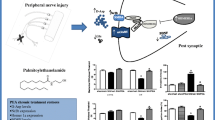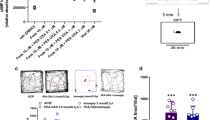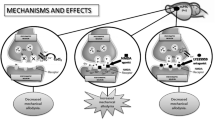Abstract
d-Aspartate (d-Asp) is a free d-amino acid detected in multiple brain regions and putative precursor of endogenous N-methyl-d-aspartate (NMDA) acting as agonist at NMDA receptors. In this study, we investigated whether d-Asp (20 mM) in drinking solution for 1 month affects pain responses and pain-related emotional, and cognitive behaviour in a model of neuropathic pain induced by the spared nerve injury (SNI) of the sciatic nerve in mice. SNI mice developed mechanical allodynia and motor coordination impairment 30 days after SNI surgery. SNI mice showed cognitive impairment, anxiety and depression-like behaviour, reduced sociability in the three chamber sociability paradigm, increased expression of NR2B subunit of NMDA receptor and Homer 1a in the medial prefrontal cortex (mPFC). The expression of (post synaptic density) PSD-95 and Shank 1was instead unaffected in the mPFC of the SNI mice. Treatment with d-Asp drinking solution, started right after the SNI (day 0), alleviated mechanical allodynia, improved cognition and motor coordination and increased social interaction. d-Asp also restored the levels of extracellular d-Asp, Homer 1a and NR2B subunit of the NMDA receptor to physiological levels and reduced Shank1 and PSD-95 protein levels in the mPFC. Amitriptyline, a tricyclic antidepressant used also to alleviate neuropathic pain in humans, reverted mechanical allodynia and cognitive impairment, and unlike d-Asp, was effective in reducing depression and anxiety-like behaviour in the SNI mice and increased PSD protein level. Altogether these findings demonstrate that d-Asp improves sensorial, motor and cognitive-like symptoms related to chronic pain possibly through glutamate neurotransmission normalization in neuropathic mice.









Similar content being viewed by others
References
al-Ghoul WM, Li Volsi G, Weinberg RJ, Rustioni A (1993) Glutamate immunocytochemistry in the dorsal horn after injury or stimulation of the sciatic nerve of rats. Brain Res Bull 30:453–459
Apkarian AV, Bushnell MC, Treede RD, Zubieta JK (2005) Human brain mechanisms of pain perception and regulation in health and disease. Eur J Pain 9:463–484
Benbouzid M, Choucair-Jaafar N, Yalcin I, Waltisperger E, Muller A, Freund-Mercier MJ, Barrot M (2008) Chronic, but not acute, tricyclic antidepressant treatment alleviates neuropathic allodynia after sciatic nerve cuffing in mice. Eur J Pain 12:1008–1017
Berrocoso E, Mico JA, Vitton O, Ladure P, Newman-Tancredi A, Depoortère R, Bardin L (2011) Evaluation of milnacipran, in comparison with amitriptyline, on cold and mechanical allodynia in a rat model of neuropathic pain. Eur J Pharmacol 655:46–51
Bliss TV, Collingridge GL (1993) A synaptic model of memory: long-term potentiation in the hippocampus. Nature 361:31–39
Boccella S, Vacca V, Errico F, Marinelli S, Squillace M, Guida F, Di Maio A, Vitucci D, Palazzo E, de Novellis V, Maione S, Pavone F, Usiello A (2015) d-Aspartate modulates nociceptive-specific neuron activity and pain threshold in inflammatory and neuropathic pain condition in mice. Biomed Res Int 2015:905906
Bradford MM (1976) A rapid and sensitive method for the quantitation of microgram quantities of protein utilizing the principle of protein-dye binding. Anal Biochem 72:248–254
Cai Z, McCaslin PP (1992) Amitriptyline, desipramine, cyproheptadine and carbamazepine, in concentrations used therapeutically, reduce kainate- and N-methyl-d-aspartate-induced intracellular Ca2+ levels in neuronal culture. Eur J Pharmacol 219:53–57
Campbell S, MacQueen G (2006) An update on regional brain volume differences associated with mood disorders. Curr Opin Psychiatry 19:25–33
Coyle JT (2012) NMDA receptor and schizophrenia: a brief history. Schizophr Bull 38:920–926
Coyle JT, Tsai G, Goff D (2003) Converging evidence of NMDA receptor hypofunction in the pathophysiology of schizophrenia. Ann N Y Acad Sci 1003:318–327
D’Aniello A (2007) d-Aspartic acid: an endogenous amino acid with an important neuroendocrine role. Brain Res Rev 53:215–234
D’Aniello A, Di Fiore MM, Fisher GH, Milone A, Seleni A, D’Aniello S, Perna AF, Ingrosso D (2000a) Occurrence of d-aspartic acid and N-methyl-d-aspartic acid in rat neuroendocrine tissues and their role in the modulation of luteinizing hormone and growth hormone release. FASEB J 14:699–714
D’Aniello G, Tolino A, D’Aniello A, Errico F, Fisher GH, Di Fiore MM (2000b) The role of d-aspartic acid and N-methyl-d-aspartic acid in the regulation of prolactin release. Endocrinology 141:3862–3870
D’Aniello S, Somorjai I, Garcia-Fernandez J, Topo E, D’Aniello A (2011) d-Aspartic acid is a novel endogenous neurotransmitter. FASEB J 25:1014–1027
de Bartolomeis A, Latte G, Tomasetti C, Iasevoli F (2014) Glutamatergic postsynaptic density protein dysfunctions in synaptic plasticity and dendritic spines morphology: relevance to schizophrenia and other behavioral disorders pathophysiology, and implications for novel therapeutic approaches. Mol Neurobiol 49:484–511
Decosterd I, Woolf CJ (2000) Spared nerve injury: an animal model of persistent peripheral neuropathic pain. Pain 87:149–158
Deffois A, Fage D, Carter C (1996) Inhibition of synaptosomal veratridine-induced sodium influx by antidepressants and neuroleptics used in chronic pain. Neurosci Lett 220:117–120
Duman RS (2014) Pathophysiology of depression and innovative treatments: remodeling glutamatergic synaptic connections. Dialogues Clin Neurosci 16:11–27
Dunlop DS, Neidle A, McHale D, Dunlop DM, Lajtha A (1986) The presence of free d-aspartic acid in rodents and man. Biochem Biophys Res Commun 14:27–32
Eisenach JC, Gebhart GF (1995) Intrathecal amitriptyline acts as an N-methyl-d-aspartate receptor antagonist in the presence of inflammatory hyperalgesia in rats. Anesthesiology 83:1046–1054
Errico F, Nisticò R, Palma G, Federici M, Affuso A, Brilli E, Topo E, Centonze D, Bernardi G, Bozzi Y, D’Aniello A, Di Lauro R, Mercuri NB, Usiello A (2008a) Increased levels of d-aspartate in the hippocampus enhance LTP but do not facilitate cognitive flexibility. Mol Cell Neurosci 37:236–246
Errico F, Rossi S, Napolitano F, Catuogno V, Topo E, Fisone G, D’Aniello A, Centonze D, Usiello A (2008b) d-aspartate prevents corticostriatal long-term depression and attenuates schizophrenia-like symptoms induced by amphetamine and MK-801. J Neurosci 28:10404–10414
Errico F, Nisticò R, Napolitano F, Mazzola C, Astone D, Pisapia T, Giustizieri M, D’Aniello A, Mercuri NB, Usiello A (2011a) Increased d-aspartate brain content rescues hippocampal age-related synaptic plasticity deterioration of mice. Neurobiol Aging 32:2229–2243
Errico F, Nisticò R, Napolitano F, Oliva AB, Romano R, Barbieri F, Florio T, Russo C, Mercuri NB, Usiello A (2011b) Persistent increase of d-aspartate in d-aspartate oxidase mutant mice induces a precocious hippocampal age-dependent synaptic plasticity and spatial memory decay. Neurobiol Aging 32:2061–2074
Errico F, Nisticò R, Di Giorgio A, Squillace M, Vitucci D, Galbusera A, Piccinin S, Mango D, Fazio L, Middei S, Trizio S, Mercuri NB, Teule MA, Centonze D, Gozzi A, Blasi G, Bertolino A, Usiello A (2014) Free d-aspartate regulates neuronal dendritic morphology, synaptic plasticity, gray matter volume and brain activity in mammals. Transl Psychiatry 4:e417
Fagg GE, Matus A (1984) Selective association of N-methyl aspartate and quisqualate types of l-glutamate receptor with brain postsynaptic densities. Proc Natl Acad Sci USA 81:6876–6880
Fan X, Jin WY, Wang YT (2014) The NMDA receptor complex: a multifunctional machine at the glutamatergic synapse. Front Cell Neurosci 8:160
Franklin KBJ, Paxinos G (1997) The mouse brain in stereotaxic coordinates. Academic Press, San Diego
Furuchi T, Homma H (2005) Free d-aspartate in mammals. Biol Pharm Bull 28:1566–1570
Giordano C, Cristino L, Luongo L, Siniscalco D, Petrosino S, Piscitelli F, Marabese I, Gatta L, Rossi F, Imperatore R, Palazzo E, de Novellis V, Di Marzo V, Maione S (2012) TRPV1-dependent and -independent alterations in the limbic cortex of neuropathic mice: impact on glial caspases and pain perception. Cereb Cortex 22:2495–2518
Gottrup H, Kristensen AD, Bach FW, Jensen TS (2003) Aftersensations in experimental and clinical hypersensitivity. Pain 103:57–64
Guida F, Luongo L, Marmo F, Romano R, Iannotta M, Napolitano F, Belardo C, Marabese I, D’Aniello A, De Gregorio D, Rossi F, Piscitelli F, Lattanzi R, de Bartolomeis A, Usiello A, Di Marzo V, de Novellis V, Maione S (2015) Palmitoylethanolamide reduces pain-related behaviors and restores glutamatergic synapses homeostasis in the medial prefrontal cortex of neuropathic mice. Mol Brain 8:47
Hall H, Ogren SO (1981) Effects of antidepressant drugs on different receptors in the brain. Eur J Pharmacol 70:393–407
Hashimoto A, Kumashiro S, Nishikawa T, Oka T, Takahashi K, Mito T, Takashima S, Doi N, Mizutani Y, Yamazaki T et al (1993) Embryonic development and postnatal changes in free d-aspartate and d-serine in the human prefrontal cortex. J Neurochem 61:348–351
Hashimoto A, Oka T, Nishikawa T (1995) Anatomical distribution and postnatal changes in endogenous free d-aspartate and d-serine in rat brain and periphery. Eur J Neurosci 7:1657–1663
Helyes Z, Németh J, Thán M, Bölcskei K, Pintér E, Szolcsányi J (2003) Inhibitory effect of anandamide on resiniferatoxin-induced sensory neuropeptide release in vivo and neuropathic hyperalgesia in the rat. Life Sci 73:2345–2353
Herrero JF, Laird JM, López-García JA (2000) Wind-up of spinal cord neurons and pain sensation: much ado about something? Prog Neurobiol 61:169–203
Hu Y, Yang J, Hu Y, Wang Y, Li W (2010) Amitriptyline rather than lornoxicam ameliorates neuropathic pain-induced deficits in abilities of spatial learning and memory. Eur J Anaesthesiol 27:162–168
Huang AS, Lee DA, Blackshaw S (2008) d-Aspartate and d-aspartate oxidase show selective and developmentally dynamic localization in mouse retina. Exp Eye Res 86:704–709
Hudson LJ, Bevan S, McNair K, Gentry C, Fox A, Kuhn R, Winter J (2002) Metabotropic glutamate receptor 5 upregulation in A-fibers after spinal nerve injury: 2-methyl-6-(phenylethynyl)-pyridine (MPEP) reverses the induced thermal hyperalgesia. J Neurosci 22:2660–2668
Hung KL, Wang SJ, Wang YC, Chiang TR, Wang CC (2014) Upregulation of presynaptic proteins and protein kinases associated with enhanced glutamate release from axonal terminals (synaptosomes) of the medial prefrontal cortex in rats with neuropathic pain. Pain 155:377–387
Hutson PH, Sarna GS, Kantamaneni BD, Curzon G (1985) Monitoring the effect of a tryptophan load on brain indole metabolism in freely moving rats by simultaneous cerebrospinal fluid sampling and brain dialysis. J Neurochem 44:1266–1273
Iasevoli F, Tomasetti C, Buonaguro EF, de Bartolomeis A (2014) The glutamatergic aspects of schizophrenia molecular pathophysiology: role of the postsynaptic density, and implications for treatment. Curr Neuropharmacol 12:219–238
Ishii Y, Sumi T (1992) Amitriptyline inhibits striatal efflux of neurotransmitters via blockade of voltage-dependent Na+ channels. Eur J Pharmacol 221:377–380
Jernigan CS, Goswami DB, Austin MC, Iyo AH, Chandran A, Stockmeier CA, Karolewicz B (2011) The mTOR signaling pathway in the prefrontal cortex is compromised in major depressive disorder. Prog Neuropsychopharmacol Biol Psychiatry 35:1774–1779
Kim PM, Duan X, Huang AS, Liu CY, Ming GL, Song H, Snyder SH (2010) Aspartate racemase, generating neuronal d-aspartate, regulates adult neurogenesis. Proc Natl Acad Sci USA 107:3175–3179
Konarski JZ, McIntyre RS, Kennedy SH, Rafi-Tari S, Soczynska JK, Ketter TA (2008) Volumetric neuroimaging investigations in mood disorders: bipolar disorder versus major depressive disorder. Bipolar Disord 10:1–37
Koolschijn PC, van Haren NE, Lensvelt-Mulders GJ, Hulshoff Pol HE, Kahn RS (2009) Brain volume abnormalities in major depressive disorder: a meta-analysis of magnetic resonance imaging studies. Hum Brain Mapp 30:3719–3735
Krashia P, Ledonne A, Nobili A, Cordella A, Errico F, Usiello A, D’Amelio M, Mercuri NB, Guatteo E, Carunchio I (2015) Persistent elevation of d-aspartate enhances NMDA receptor-mediated responses in mouse substantia nigra pars compacta dopamine neurons. Neuropharmacology 103:69–78
Kullmann DM, Asztely F, Walker MC (2000) The role of mammalian ionotropic receptors in synaptic plasticity: LTP, LTD and epilepsy. Cell Mol Life Sci 57:1551–1561
Lavoie PA, Beauchamp G, Elie R (1990) Tricyclic antidepressants inhibit voltage-dependent calcium channels and Na(+)-Ca2+ exchange in rat brain cortex synaptosomes. Can J Physiol Pharmacol 68:1414–1418
Lee JA, Homma H, Tashiro K, Iwatsubo T, Imai K (1999) d-Aspartate localization in the rat pituitary gland and retina. Brain Res 838:193–199
McCaslin PP, Yu XZ, Ho IK, Smith TG (1992) Amitriptyline prevents N-methyl-d-aspartate (NMDA)-induced toxicity, does not prevent NMDA-induced elevations of extracellular glutamate, but augments kainate-induced elevations of glutamate. J Neurochem 59:401–405
Millecamps M, Centeno MV, Berra HH, Rudick CN, Lavarello S, Tkatch T, Apkarian AV (2007) D-cycloserine reduces neuropathic pain behavior through limbic NMDA-mediated circuitry. Pain 132:108–123
Monahan JB, Michel J (1987) Identification and characterization of an N-methyl-d-aspartate-specific l-[3H]glutamate recognition site in synaptic plasma membranes. J Neurochem 48:1699–1708
Neidle A, Dunlop DS (1990) Developmental changes in free d-aspartic acid in the chicken embryo and in the neonatal rat. Life Sci 46:1517–1522
Neugebauer V, Galhardo V, Maione S, Mackey SC (2009) Forebrain pain mechanisms. Brain Res Rev 60:226–242
Nithianantharajah J, Hannan AJ (2013) Dysregulation of synaptic proteins, dendritic spine abnormalities and pathological plasticity of synapses as experience-dependent mediators of cognitive and psychiatric symptoms in Huntington’s disease. Neuroscience 251:66–74
Orsetti M, Colella L, Dellarole A, Canonico PL, Ghi P (2007) Modification of spatial recognition memory and object discrimination after chronic administration of haloperidol, amitriptyline, sodium valproate or olanzapine in normal and anhedonic rats. Int J Neuropsychopharmacol 10:345–357
Ota N, Shi T, Sweedler JV (2012) d-Aspartate acts as a signaling molecule in nervous and neuroendocrine systems. Amino Acids 43:1873–1886
Pancrazio JJ, Kamatchi GL, Roscoe AK, Lynch C 3rd (1998) Inhibition of neuronal Na+ channels by antidepressant drugs. J Pharmacol Exp Ther 284:208–214
Paul IA, Skolnick P (2003) Glutamate and depression: clinical and preclinical studies. Ann N Y Acad Sci 1003:250–272
Pilc A, Wierońska JM, Skolnick P (2013) Glutamate-based antidepressants: preclinical psychopharmacology. Biol Psychiatry 73:1125–1132
Reynolds IJ, Miller RJ (1988) Tricyclic antidepressants block N-methyl-d-aspartate receptors: similarities to the action of zinc. Br J Pharmacol 95:95–102
Sakai K, Homma H, Lee JA, Fukushima T, Santa T, Tashiro K, Iwatsubo T, Imai K (1998) Emergence of d-aspartic acid in the differentiating neurons of the rat central nervous system. Brain Res 808:65–71
Sanacora G, Treccani G, Popoli M (2012) Towards a glutamate hypothesis of depression: an emerging frontier of neuropsychopharmacology for mood disorders. Neuropharmacology 62(1):63–77
Shibata K, Sugaya N, Ono W, Abe K, Takahashi S, Kera Y (2011) Determination of d-aspartate N-methyltransferase activity in the starfish by direct analysis of N-methyl-d-aspartate with high-performance liquid chromatography. J Chromatogr B Analyt Technol Biomed Life Sci 879:3229–3234
Shimizu M, Nishida A, Yamawaki S (1992) Antidepressants inhibit spontaneous oscillations of intracellular Ca2+ concentration in rat cortical cultured neurons. Neurosci Lett 146:101–104
Sindrup SH, Otto M, Finnerup NB, Jensen TS (2005) Antidepressants in the treatment of neuropathic pain. Basic Clin Pharmacol Toxicol 96:399–409
Skolnick P, Popik P, Trullas R (2009) Glutamate-based antidepressants: 20 years on. Trends Pharmacol Sci 30:563–569
Spinelli P, Brown ER, Ferrandino G, Branno M, Montarolo PG, D’Aniello E, Rastogi RK, D’Aniello B, Baccari GC, Fisher G, D’Aniello A (2006) d-Aspartic acid in the nervous system of Aplysia limacina: possible role in neurotransmission. J Cell Physiol 206:672–681
Swanson CJ, Bures M, Johnson MP, Linden AM, Monn JA, Schoepp DD (2005) Metabotropic glutamate receptors as novel targets for anxiety and stress disorders. Nat Rev Drug Discov 4:131–144
Watanabe Y, Saito H, Abe K (1993) Tricyclic antidepressants block NMDA receptor-mediated synaptic responses and induction of long-term potentiation in rat hippocampal slices. Neuropharmacol 32:479–486
Wei H, Panula P, Pertovaara A (2001) Modulation of pain by [1DMe]NPYF, a stable analogue of neuropeptide FF, in neuropathic rats. Brain Res 900:234–243
Wolosker H, D’Aniello A, Snyder SH (2000) d-Aspartate disposition in neuronal and endocrine tissues: ontogeny, biosynthesis and release. Neuroscience 100:183–189
Woolf CJ, Salter MW (2000) Neuronal plasticity: increasing the gain in pain. Science 288:1765–1769
Wu LJ, Zhuo M (2009) Targeting the NMDA receptor subunit NR2B for the treatment of neuropathic pain. Neurotherapeutics 6(4):693–702
Acknowledgments
This work was financially supported by the Ministero Istruzione, Università e Ricerca, Project n° PRIN 2012WBSSY4_001.
Author information
Authors and Affiliations
Corresponding author
Ethics declarations
Conflict of interest
All the authors who took part in this study declare that they have nothing to disclose regarding competing interests or funding with respect to this manuscript.
Ethical approval
All applicable international, national, and/or institutional guidelines for the care and use of animals were followed (Animal Ethics Committee of the Second University of Naples in compliance with the IASP and European Community (E.C. L358/1 18/12/86). All procedures were in accordance with the Animal Ethics Committee of the Second University of Naples. This article does not contain any studies with human participants performed by any of the authors.
Additional information
Handling Editor: N. Singewald.
Rights and permissions
About this article
Cite this article
Palazzo, E., Luongo, L., Guida, F. et al. d-Aspartate drinking solution alleviates pain and cognitive impairment in neuropathic mice. Amino Acids 48, 1553–1567 (2016). https://doi.org/10.1007/s00726-016-2205-4
Received:
Accepted:
Published:
Issue Date:
DOI: https://doi.org/10.1007/s00726-016-2205-4




